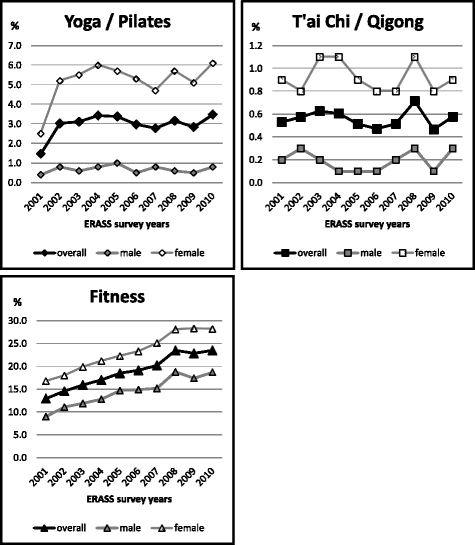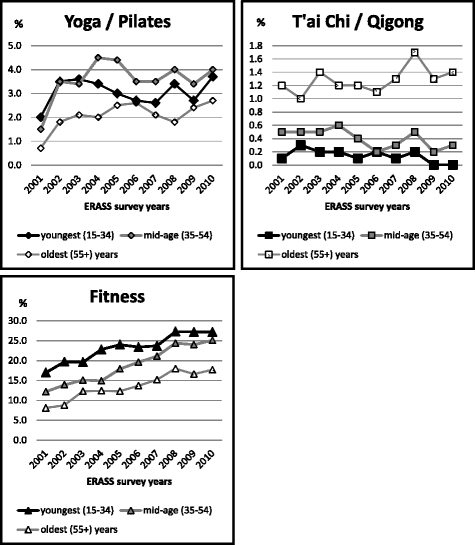Participation trends in holistic movement practices: a 10-year comparison of yoga/Pilates and t'ai chi/qigong use among a national sample of 195,926 Australians
- PMID: 28587599
- PMCID: PMC5461749
- DOI: 10.1186/s12906-017-1800-6
Participation trends in holistic movement practices: a 10-year comparison of yoga/Pilates and t'ai chi/qigong use among a national sample of 195,926 Australians
Abstract
Background: In recent decades, the evidence supporting the physical and mental health benefits of holistic movement practices such as yoga and t'ai chi have become increasingly established. Consequently, investigating the participation prevalence and patterns of these practices is a relevant pursuit in the public health field. Few studies have provided population-level assessment of participation rates, however, and even fewer have focused on patterns over time. The purpose of this study was to examine participation prevalence and trends in yoga/Pilates and t'ai chi/qigong over a ten-year period in a nationally representative sample of Australians aged 15 years and over, with particular attention to sex and age. A secondary purpose was to juxtapose these findings with participation trends in traditional fitness activities over the same period.
Methods: Data comprised modes and types of physical activity, age, and sex variables collected through the Exercise, Recreation and Sport Survey (ERASS), a series of independent cross-sectional Australia-wide surveys conducted yearly between 2001 and 2010. For each year, weighted population estimates were calculated for those participating in yoga/Pilates, t'ai chi/qigong, and fitness activities (e.g. aerobics, calisthenics). Linear regression and multiple logistic regression analyses were used to examine trends in prevalence rates over time and differences among sex and age (15-34; 35-54; 55+ years) groups, respectively.
Results: Average prevalence rates between 2001 and 2010 were 3.0% (95% CI 2.9-3.1) for yoga/Pilates, 0.6% (95% CI 0.5-0.6) for t'ai chi/qigong, and 19.2% (95% CI 18.9-19.4) for fitness activities. Across the decade, overall participation rates remained relatively stable for yoga/Pilates and t'ai chi/qigong, while increasing linearly for fitness activities. For both genders and in all three age groups, participation in fitness activities increased, whereas only in the 55+ age group was there a significant increase in yoga/Pilates participation; participation in t'ai chi/qigong declined significantly in the two younger age groups.
Conclusions: Participation rates in yoga/Pilates and t'ai chi/qigong in Australia were low and relatively stable. As fitness activities increased in popularity across the decade, holistic movement practices did not. These findings point to the need to investigate activity-specific barriers and facilitators to participation, including intrapersonal, interpersonal, organisational, and environmental factors.
Keywords: Holistic; Mind-body; Participation prevalence; Physical activity surveillance; Pilates; Qigong; Tai chi; Yoga.
Figures
Similar articles
-
Participant characteristics of users of holistic movement practices in Australia.Complement Ther Clin Pract. 2018 May;31:181-187. doi: 10.1016/j.ctcp.2018.02.011. Epub 2018 Feb 14. Complement Ther Clin Pract. 2018. PMID: 29705453
-
T'ai chi and qigong for health: patterns of use in the United States.J Altern Complement Med. 2009 Sep;15(9):969-73. doi: 10.1089/acm.2009.0174. J Altern Complement Med. 2009. PMID: 19757974 Free PMC article.
-
Prevalence, Patterns, and Predictors of T'ai Chi and Qigong Use in the United States: Results of a Nationally Representative Survey.J Altern Complement Med. 2016 Apr;22(4):336-42. doi: 10.1089/acm.2015.0356. Epub 2016 Mar 16. J Altern Complement Med. 2016. PMID: 26981616
-
Complementary and integrative health interventions in post-stroke rehabilitation: a systematic PRISMA review.Disabil Rehabil. 2022 Jun;44(11):2223-2232. doi: 10.1080/09638288.2020.1830440. Epub 2020 Oct 12. Disabil Rehabil. 2022. PMID: 33044872
-
Treating survivors of torture and refugee trauma: a preliminary case series using qigong and t'ai chi.J Altern Complement Med. 2008 Sep;14(7):801-6. doi: 10.1089/acm.2007.0736. J Altern Complement Med. 2008. PMID: 18803491 Free PMC article. Review.
Cited by
-
Mind-body therapy for cardiometabolic risk in U.S. middle-aged Black adults: a scoping review.Front Public Health. 2025 Feb 20;13:1480369. doi: 10.3389/fpubh.2025.1480369. eCollection 2025. Front Public Health. 2025. PMID: 40051519 Free PMC article.
-
Sport participation settings: where and 'how' do Australians play sport?BMC Public Health. 2020 Sep 3;20(1):1344. doi: 10.1186/s12889-020-09453-3. BMC Public Health. 2020. PMID: 32883274 Free PMC article.
-
The effect of Imaginary Working Qigong on the psychological well-being of college students: Study protocol for a randomized controlled trial.Medicine (Baltimore). 2018 Nov;97(44):e13043. doi: 10.1097/MD.0000000000013043. Medicine (Baltimore). 2018. PMID: 30383672 Free PMC article. Clinical Trial.
-
The effect of Three-Circle Post Standing (Zhanzhuang) Qigong on the physical and psychological well-being of college students: Study protocol for a randomized controlled trial.Medicine (Baltimore). 2018 Sep;97(38):e12323. doi: 10.1097/MD.0000000000012323. Medicine (Baltimore). 2018. PMID: 30235685 Free PMC article. Clinical Trial.
-
The effects of yoga compared to active and inactive controls on physical function and health related quality of life in older adults- systematic review and meta-analysis of randomised controlled trials.Int J Behav Nutr Phys Act. 2019 Apr 5;16(1):33. doi: 10.1186/s12966-019-0789-2. Int J Behav Nutr Phys Act. 2019. PMID: 30953508 Free PMC article.
References
-
- Brown D, Leledaki A. Eastern movement forms as body-self transforming cultural practices in the west: towards a sociological perspective. Cult Sociol. 2010;4(1):123–154. doi: 10.1177/1749975509356866. - DOI
-
- DeMichelis E. A history of modern yoga: Patanjali and western esotericism. London: Bloomsbury; 2004.
-
- Vergeer I. Participation motives for a holistic dance-movement practice. Int J Sport Exercise Psy. 2016. doi:10.1080/1612197X.2016.1167759.
MeSH terms
LinkOut - more resources
Full Text Sources
Other Literature Sources
Research Materials



